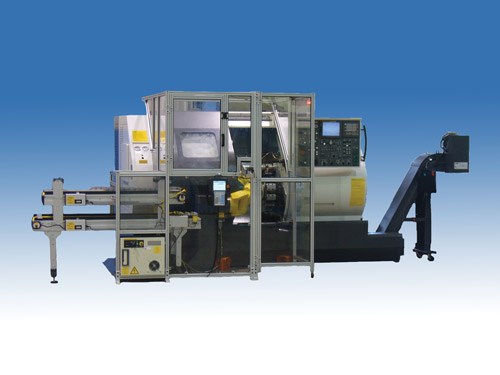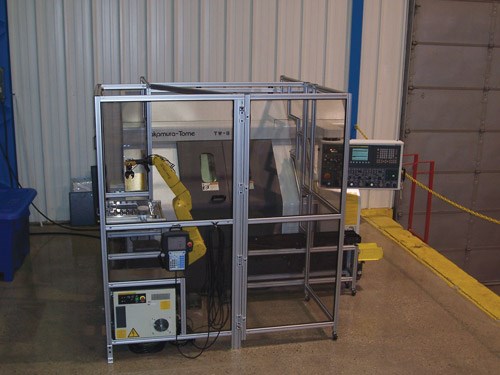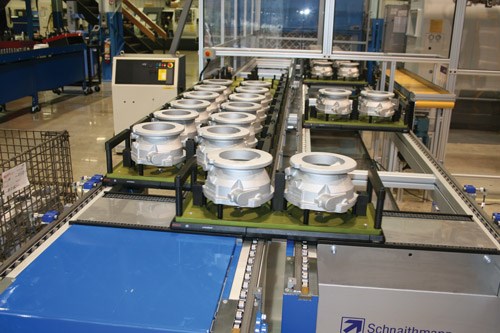Practical Automation for a Variety of Turning Applications
A key way to reduce labor costs on turning centers is to add automation for part loading and unloading.
In the ongoing quest to reduce part cost, inevitably, the place to look is labor. To reduce labor costs, turn to automation. A key way to reduce labor costs on turning centers is to consider automation for part loading and unloading.
One of the simplest and oldest types of automated machining is the combination of a turning machine and bar feeder. Remember the heyday of the screw machine shop when, with minimal labor, millions of parts seemed to flow out of the semi untended machines? Even today, the most prevalent way to automate a turning center is to outfit the machine with a bar feeder. This popularity is evident by the number of companies selling bar feeders today.
However, for a variety of reasons, not all jobs lend themselves to being processed this way. Some examples of “non-bar” parts applications include pre-machined parts, forged/cast parts or parts that are too big to be made from bar. A couple of less evident justifications that make for a “non-bar” application are part quality and machine size. Part quality can be negatively impacted by the effects of the spinning bar. Spinning bars can vibrate, and this can affect part tolerances, runout and especially part finish. Often, spindle speeds are lowered to diminish this problem, and this can affect cutting conditions and cycle time. By loading slugs of material, these problems can be avoided and, in many cases, result in increased spindle speed and reduced cycle time. In addition, when loading slugs, a part can be run on a smaller, faster, and typically less expensive machine than one that requires a particular spindle bore size to accommodate a bar. Importantly, just like a bar-fed machine, applying automation to a turning center can allow non-bar types of jobs to be run with little or no operator labor.
A Variety of Considerations
Several different types of automation are available for turning centers. The bar feeder is certainly one of the most popular forms of automation for a turning center. Articulating-arm robots and fixed-rail Cartesian robots are also popular forms of automation. In addition, different kinds of “hard” automation, engineered with cylinders, slides, and so on, are offered in standard designs to be put in front of any turning center, or may be custom designed for a specific application.
Who should consider turning center automation? The answer will depend on the type of automation, parts and lot sizes. Large, heavy parts have always been a significant labor draw when loading them into and out of the machine, so shops doing this type of work can often benefit from automation. And with the increasing development of systems that quickly perform change-overs, even job shops that can set up for less than a day’s worth of production can benefit from automation.
Manufacturers with families of parts, including those with small lot sizes, are also candidates for automation. For many years, robots and automated machines have been used in large automotive shops, making millions of the same part. In turn, many shop owners concluded that robots and automated systems were so complex that they should only be considered for making large quantities of the same parts.
However, automation systems can be configured to support many different requirements. For example, with automation systems using robots, the robot itself is a device that moves based on a set of instructions. The robot and the associated system can be configured to support unique requirements. Automated systems can be considered for applications involving high volume parts as well as those with high mix/lower volume parts.
Practical Solutions
The following are three different examples of practical, efficient, automated options for a variety of turning applications.
The first example is a robotic turning center for a basic job shop. The design goal for this solution was to produce an automation cell that allowed for quick change-overs to accommodate different jobs. This type of automation could be used on any type of turning center, including simple single-spindle/single-turret turning, twin-spindle/twin-turret turning centers, and multi-axis tool changer-style machines. In a job shop environment, it is not common to know what jobs are coming up, so a majority of these parts are made from cut up, round barstock. One of the keys to this design is an in-feed conveyor with adjustable side rails that will allow quick and easy adjustment for different sized round slugs of material, including a proximity switch at the end of the conveyor lane to confirm that a part is present. The out-feed conveyor is mounted under the in-feed conveyor for space savings. A two-gripper design allows a single trip into the machine to unload finished parts and load the raw slug. Also, the fingers on the grippers are easily changed to accommodate different sized slugs. The users of this type of automation do not need to re-program the robot, but will need only to “re-teach” the pickup and load points as needed. By purchasing a flexible automation solution with features that allow it to be quickly changed over, a job shop or other lower volume manufacturer can benefit from automation on a turning center.
The second automation example builds on the basic job shop cell and modifies it for a customer’s specific requirements. This particular customer produces a family of spacers including many different diameters and widths. Their machine was a twin-spindle/twin-turret turning center with no milling. Machining operations included basic turning, boring and facing to length on each side. Their requirement is classic “just-in-time” manufacturing, including small lot sizes with the ability to run any size spacer job with no setup time for automation.
A solution was achieved by two main modifications to the basic job shop cell—the grippers and the in-feed system. The in-feed system is configured with a drawer that the operator can slide out to replenish the raw parts. The drawer contains a pallet with an array of circles milled into it. The raw spacer blanks are placed in the circles to retain the raw blank in an approximate position. A three-jaw long stroke gripper is used for picking raw parts. The long stroke enables the gripper to pick up any diameter blank within the family of parts, facilitating no changing of grippers or fingers for any of the parts. The automation system gives the end user the ability to run any of the parts in their family, at any time, with no automation change-over. No change-over provides more time to run parts and offers the flexibility to run short or long lot sizes, depending on what is needed. It removes any necessity to run longer lot sizes just to make each setup cost effective.
In a third automation example, a large manufacturer also needed shorter setup time between parts. This customer had three different cast parts they wanted to run through a twin-spindle turning center with a B-axis milling head and separate turret. A substantial amount of turning and boring work, as well as milling, is used to manufacture these cast parts. On the first operation, there is rough and finished turning of an alignment diameter, facing the casting to length, and rough/finish boring of a large ID. On a second operation, the cast part is again faced to length with processes including turning of the pointed nose, drilling and finish boring of the small ID. While the second automation example had a series of similar parts, allowing for use of only one long stroke gripper for the entire family of parts, this collection of cast parts is completely different and therefore, requires three different grippers.
By outfitting the robot with an automatic quick-change adapter and storing all three grippers in a position where a robot can access them, the robot is able to automatically change between any of the different grippers. To accommodate the three different gripper shapes and present these parts properly to the robot, a pallet conveyor was chosen for the in-feed/out-feed system. As the name describes, a pallet conveyor is a system that conveys pallets into and out of the cell.
The pallets are designed with replaceable tops with one set of tops designated for each different part. When changing between jobs, the operator only needs to replace the top pallet. This particular cell allows enough parts to be in queue to allow the system to run for about a full shift with no operator intervention. This cell also uses a top-loader robot on an overhead rail, allowing it to access the machine, the pallet conveyor and all the additional tools. This type of overhead robot also allows for robot storage away from the machine. This leaves the front of the machine open for access for servicing the machine, setups, tool changes, and so on.
No automation setup between jobs means more time to run parts and allows the flexibility to run long or short runs, depending on what is needed. While there was flexibility designed into the system to run any of the three different parts, this automation system was customized specifically around the end user’s requirements.
In all, automation systems can be designed to make the system work for different needs. Whether a job shop with a variety of applications, or a manufacturer with a product line and a specific need, an automation system can be designed to support those requirements.
System Integrators are Key
Turning centers lend themselves well to automation, and solutions can be designed to accommodate different requirements. Working closely with a reputable system integrator will yield the best results. An integrator applies the robot electrically and mechanically to perform its task. Some machine tool companies have their own integration people on staff, giving customers “one-stop shopping” for the machine and automation, and thus, one group is responsible for the entire system. Another way to work with an integrator is to go to an integration company that specializes in integrating robots to machine tools. The integrator handles various items, including interfacing the robot to the machine and to other ancillary equipment. This expert can also design, purchase and integrate grippers, the in-feed/out-feed system and a safety fence, in addition to conducting training.
It is important to accurately explain to the integrator what the expectations are for the automation. If a shop is looking to manufacture a million of a certain part, the automation solution will be customized for the part with minimal need for change-overs. When producing a family of parts, some customization for the parts may be required, but emphasis will be placed on flexibility to run different parts with quick change-overs. A more generic, standard automation solution requiring maximum flexibility and quick change-overs may be best suited for making many different parts at a low volume. With the proper expertise, an automated turning solution can be incorporated to meet a shop’s unique requirements. And this will lead to increasing productivity and decreasing part cost.
Related Content
Broaching Tool Technology For Lathes Used to Slot Inconel Parts
This shop finds value in using an indexable-insert-style broaching tool to create blind-hole slots in heat-treated Inconel aerospace parts on a CNC lathe.
Read MoreBreaking the Barriers for Small Tool Breakage Detection
This contact-free tool breakage detector, especially useful for machine tools with small tools and small workzones, offers a quick and efficient way to change out broken tools before they cause bigger problems.
Read MoreTool Path Improves Chip Management for Swiss-Type Lathes
This simple change to a Swiss-type turning machine’s tool path can dramatically improve its ability to manage chips.
Read MoreReplaceable-Insert Spade Drill Basics, Advantages
Although solid carbide and indexable-insert drills have their place in a machine shop, replaceable-insert spade drills offer specific advantages for various holemaking operations on machining centers and lathes.
Read MoreRead Next
Handling Parts In A Robotic Cell
Here’s a review of the workholding and workhandling challenges a shop faces as it moves a part through a robotic cell, from serving up the blanks to the transfer of the final workpiece to post processing and gaging. Productivity, Inc. takes the reader through a few of their cells that they've installed using Fanuc robots and a variety of other machine tool equipment.
Read MoreDo You Have Single Points of Failure?
Plans need to be in place before a catastrophic event occurs.
Read MoreA Tooling Workshop Worth a Visit
Marubeni Citizen-Cincom’s tooling and accessory workshop offers a chance to learn more about ancillary devices that can boost machining efficiency and capability.
Read More















.jpg;maxWidth=300;quality=90)









